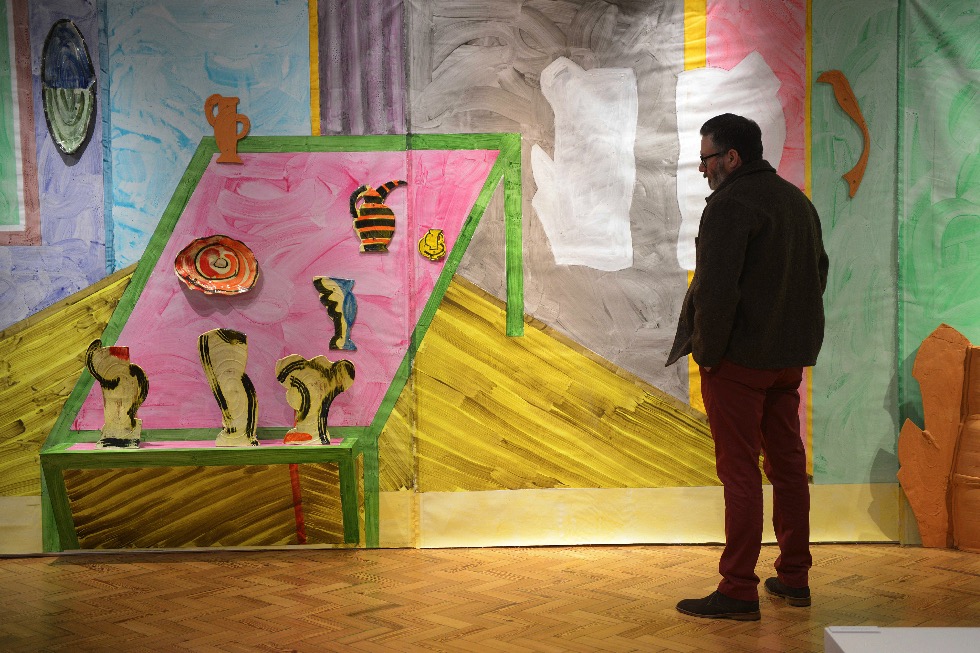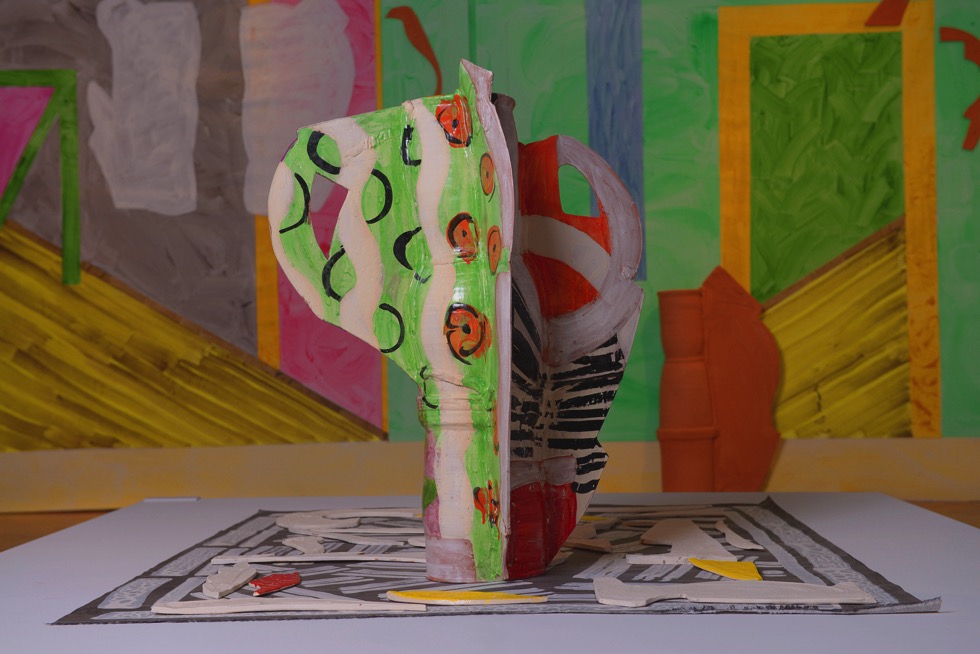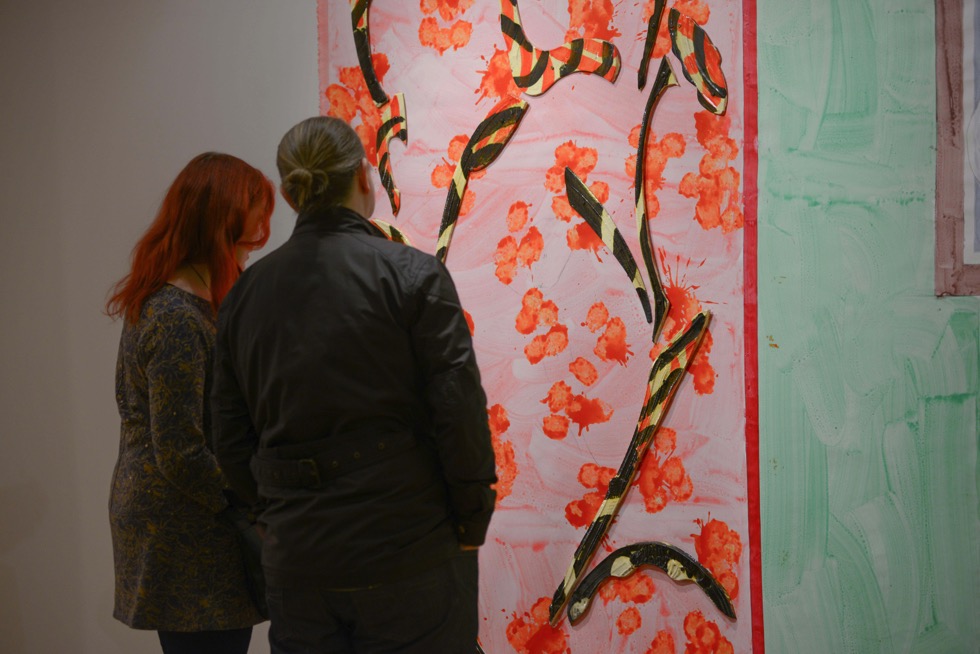“A fitting tribute to a truly original artist”: Betty Woodman’s Posthumous Ceramics With Painting Of The Modern Age

Jack Welsh pays tribute to a trailblazing female artist who liberated paint from the canvas and challenged the 3D, traditional use of clay…
Surprisingly, an octogenarian ceramicist produced one of the most dynamic new commissions of the 2016 Liverpool Biennial. Set (to this day) at the base of George’s Dock Ventilation Tower, Liverpool Fountain (2016) beautifully embodied the sheer ambition and verve of Betty Woodman’s oeuvre. As a working bronze fountain, comprising of crafted totemic fragments and copper piping, it fused a myriad of references – drawing inspiration from the Egyptian influence on Liverpool’s neo-classical architecture – into a visceral installation. Like many of Woodman’s works, it blurs the boundaries between the aesthetic and functional.
2018 dawned with sad news of Woodman’s passing on 2 January. Despite reaching the ripe age of 87, many felt a keen sense of loss for an artist who, remarkably, had creatively thrived during her last decade. She became the first living women to be awarded a retrospective at Metropolitan Museum in New York in 2006. Woodman didn’t decline as she aged; she roared forwards.
Poignantly, her new exhibition at Cooper Gallery in Barnsley, the penultimate exhibition of the Liverpool Biennial Touring Programme, is the first since her death. At its heart are two works exhibited which formed part of the Biennial’s Ancient Greece episode in 2016. Ceramics with Painting of the Modern Age serves as both an introduction and celebration of her work.
Woodman’s large-scale installation The Summer House (2015) dominates. Perfectly fitted within the gallery, this theatrical mise-en-scéne depicts a domestic interior, spanning four large panels made from painted and lacquered canvas and wood, with little ceramic forms fixed to it and several overlapping perspectives. It’s a riot of colour and form. Well travelled, Woodman drew on an unusually eclectic range of cultural inspiration for her work, from Etruscan pottery to ukiyo-e prints to Aztec crafts. Her bright, expressive palette recalls Matisse and Bonnard; I’m struck by the effortless energy of her swirling brushwork, with each stroke – somehow – appearing still wet.

A painterly dining table deliberately juts off the canvas into three-dimensional space. Negative space is accentuated by paint. Several distorted ceramic pieces perch on it, with their sculptural forms protruding from the canvas. What makes The Summer House so resonant is how it dismantles the boundaries between painting and sculpture, art and craft, domesticity and functionality. Colour pops and radiates under the gallery lights; I can’t tear my eyes away.
The vase is a key motif in Woodman’s work. Open to interpretation as a vessel, a bodily metaphor or art historical reference, Woodman liberated the vase by dynamically deconstructing, flattening, painting and glazing it. This process radically challenged its traditional form. Aztec Vase and Carpet #1 (2012) is such an example. Flat handles protrude from the pot at various angles; strips of black and green paint adorn its glazed earthenware surface, referencing Ancient Greek designs. It sits on a black and white carpet, surrounded by pale ceramic fragments. Several brightly coloured forms interject, displayed like trophies from an archaeological dig. A walk around the vase creates fresh perspectives, new dabs of colour and dramatically altered forms; Woodman once joked that her sculptural works are really two paintings in one.
Woodman’s 2016 solo exhibition The Theatre of the Domestic at ICA London, her first at a British institution, presented a number of new works on small plinths and the floor. Viewers could walk between vessels, with the spatial relationship between works considered just as crucial. This curatorial gesture reinforced Woodman’s extraordinary experimentation across ceramics and sculpture. It’s a shame that Aztec Vase and Carpet #1 sits on a plinth; its cumbersome presence dilutes its material dynamism.
As the exhibition was being finalised, Woodman requested the inclusion of the 1991 documentary Thinking Out Loud. Filmed on glorious VHS by her son Charles, it depicts Woodman discussing her work with critic John Perreault. We see footage of her rolling clay in the studio. At the wheel throwing vases. Fixing thick jug-eared slabs of clay onto large pots. She is in complete command of her art. It’s worth watching just to witness Woodman’s incredible, liberated application of paint to her Kimono Vases.

Given the context, its screening is poignant. Artworld recognition arrived late in Woodman’s life. Her sheer determination overcame the considerable barriers of being a woman and also the previously unfashionable nature of ceramics. The recent resurgence of ceramics within contemporary art has fuelled wider interest in her work. What Thinking Out Loud makes crystal clear is that Woodman blazed her own trail for decades – regardless of artistic trends. Importantly, its inclusion also avoids the exhibition becoming a bland rehash of two works previously exhibited during Liverpool Biennial. While concise, Ceramics with Painting of the Modern Age is a fitting tribute to a truly original artist.
But, as part of this inaugural touring programme, what impact will the exhibition have for Cooper Gallery?
In 2017, Barnsley and Rotherham received £1,264,000 Heritage Lottery Funding as part of Great Place Scheme initiative. It aims to use cultural regeneration as a catalyst to regenerate heritage sites in the region. This includes working with deprived local communities hit hard by industrial decline. Raising cultural engagement and local pride is high on the agenda.
That same year, Cooper Gallery hosted a Picasso Linocuts exhibition on loan from the British Museum. Along with the opening of a new gallery extension, this led to a 46% attendance bump for the year. Such projects can support the gallery by raising its profile, enticing new visitors and bringing high quality art to existing audiences. Speaking with Alison Cooper, Cooper’s Gallery Officer, at the opening, I hear about its year-long programme of workshops, with many events often selling out.
Cooper Gallery has produced a vibrant supporting education programme alongside the exhibition. Local ceramicists are running several vessel-making and clay-sculpting workshops for kids. Staff from Liverpool Biennial’s curatorial and education teams have led exhibition tours. Nationally renowned poets Helen Mort and Ian McMillian are delivering language-based workshops inspired by Woodman’s work. The programme wraps up with a Gentle Protest stitching and spoken word event. Overall, the programme promises to add depth to the exhibition, increasing opportunities for local audiences to engage with Woodman’s work: who wouldn’t want to try daubing wet paint on clay?
It seems important that the Biennial is only loosely connected to the education programme. If long-term capacity and ambition is to increase, then such partnerships must support existing work on the ground in a genuine way. It’s hard to overstate the cultural significance of pioneering artists like Betty Woodman exhibiting in Barnsley.
Jack Welsh
See Betty Woodman: Ceramics with Painting of the Modern Age at Cooper Gallery, Barnsley, until Saturday 7 April 2018
This original article has been co-commissioned by Liverpool Biennial and The Double Negative to celebrate the Biennial’s Touring Programme in 2017-8. The tour sees artworks by leading international artists who exhibited at the 2016 Biennial travel to six different locations in Northern England: Barnsley, Brierfield, Bury, Leeds, Leigh and Rochdale. Read more here and here
Images, from top: Betty Woodman; The Summer House, 2015. Installation view at the Cooper Gallery, January 2018. Image courtesy Liverpool Biennial. Photo: Scott Bairstow. Betty Woodman, Aztec Vase and Carpet #1, 2012. Installation view at the Cooper Gallery, January 2018. Image courtesy Liverpool Biennial. Photo: Scott Bairstow





